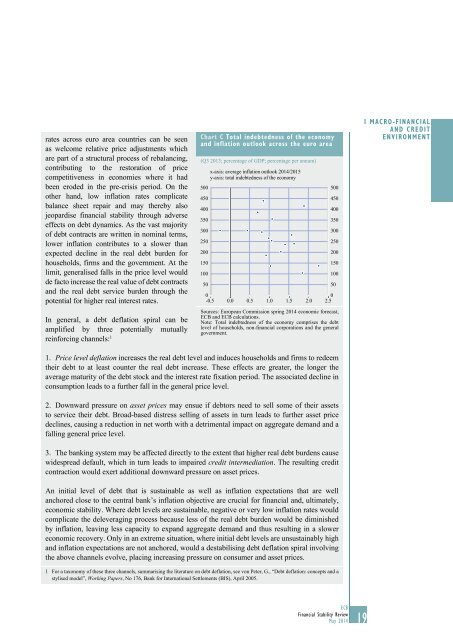Create successful ePaper yourself
Turn your PDF publications into a flip-book with our unique Google optimized e-Paper software.
ates across euro area countries can be seen<br />
as welcome relative price adjustments which<br />
are part of a structural process of rebalancing,<br />
contributing to the restoration of price<br />
competitiveness in economies where it had<br />
been eroded in the pre-crisis period. On the<br />
other hand, low inflation rates complicate<br />
balance sheet repair and may thereby also<br />
jeopardise financial stability through adverse<br />
effects on debt dynamics. As the vast majority<br />
of debt contracts are written in nominal terms,<br />
lower inflation contributes to a slower than<br />
expected decline in the real debt burden for<br />
households, firms and the government. At the<br />
limit, generalised falls in the price level would<br />
de facto increase the real value of debt contracts<br />
and the real debt service burden through the<br />
potential for higher real interest rates.<br />
In general, a debt deflation spiral can be<br />
amplified by three potentially mutually<br />
reinforcing channels: 1<br />
Chart C Total indebtedness of the economy<br />
and inflation outlook across the euro area<br />
(Q3 2013; percentage of GDP; percentage per annum)<br />
500<br />
450<br />
400<br />
350<br />
300<br />
250<br />
200<br />
150<br />
100<br />
50<br />
x-axis: average inflation outlook 2014/2015<br />
y-axis: total indebtedness of the economy<br />
0<br />
0<br />
-0.5 0.0 0.5 1.0 1.5 2.0 2.5<br />
500<br />
450<br />
400<br />
350<br />
300<br />
250<br />
200<br />
150<br />
100<br />
Sources: European Commission spring 2014 economic forecast,<br />
ECB and ECB calculations.<br />
Note: Total indebtedness of the economy comprises the debt<br />
level of households, non-financial corporations and the general<br />
government.<br />
50<br />
I Macro-FInancIal<br />
and credIt<br />
EnvIronment<br />
1. Price level deflation increases the real debt level and induces households and firms to redeem<br />
their debt to at least counter the real debt increase. These effects are greater, the longer the<br />
average maturity of the debt stock and the interest rate fixation period. The associated decline in<br />
consumption leads to a further fall in the general price level.<br />
2. Downward pressure on asset prices may ensue if debtors need to sell some of their assets<br />
to service their debt. Broad-based distress selling of assets in turn leads to further asset price<br />
declines, causing a reduction in net worth with a detrimental impact on aggregate demand and a<br />
falling general price level.<br />
3. The banking system may be affected directly to the extent that higher real debt burdens cause<br />
widespread default, which in turn leads to impaired credit intermediation. The resulting credit<br />
contraction would exert additional downward pressure on asset prices.<br />
An initial level of debt that is sustainable as well as inflation expectations that are well<br />
anchored close to the central bank’s inflation objective are crucial for financial and, ultimately,<br />
economic stability. Where debt levels are sustainable, negative or very low inflation rates would<br />
complicate the deleveraging process because less of the real debt burden would be diminished<br />
by inflation, leaving less capacity to expand aggregate demand and thus resulting in a slower<br />
economic recovery. Only in an extreme situation, where initial debt levels are unsustainably high<br />
and inflation expectations are not anchored, would a destabilising debt deflation spiral involving<br />
the above channels evolve, placing increasing pressure on consumer and asset prices.<br />
1 For a taxonomy of these three channels, summarising the literature on debt deflation, see von Peter, G., “Debt deflation: concepts and a<br />
stylised model”, Working Papers, No 176, Bank for International Settlements (BIS), April 2005.<br />
ECB<br />
Financial Stability Review<br />
19<br />
May 2014 19


